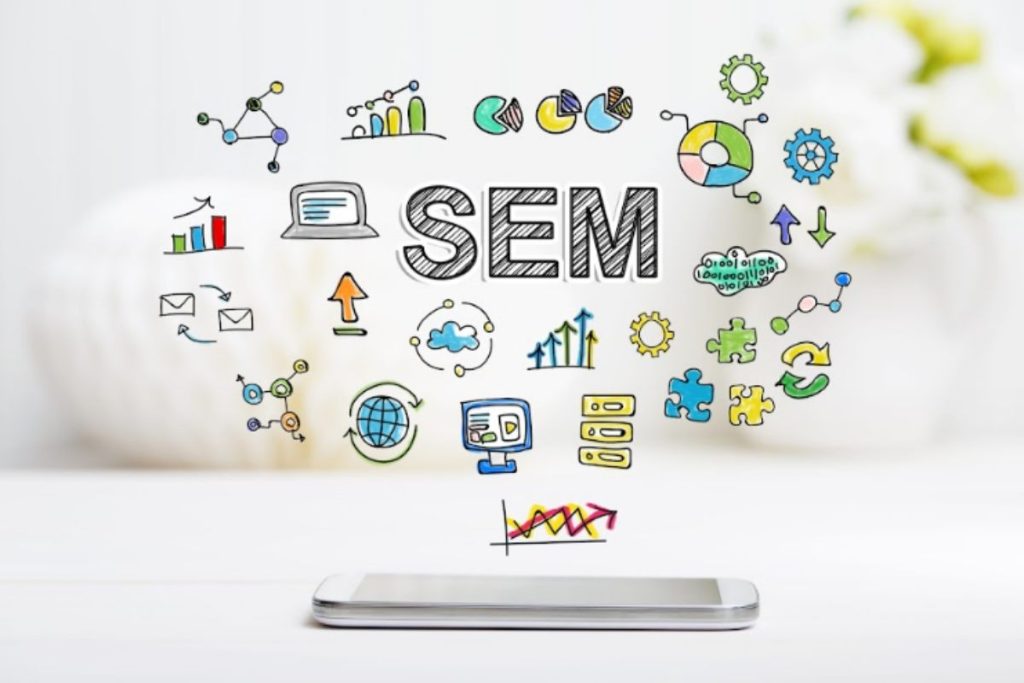SEM Ad: At the heart of your victorious SEM campaign lies a meticulously crafted ad. Every component, from your headline to the conversion, should captivate potential customers. This guide dives into the anatomy of a successful SEM ad, offering insights into how you can craft ads that not only capture attention but also lead to conversions.
Table of Contents
What Is Search Engine Marketing?

Search Engine Marketing (SEM) is a digital marketing strategy that increases your website’s visibility in search engine results pages (SERPs). It involves promoting your website by enhancing its visibility through paid advertising, which may include pay-per-click (PPC) ads, cost-per-thousand impressions (CPM) ads, and other forms of search engine advertising. SEM encompasses both the activities involved in setting up and optimizing your ads and allocating a budget for your ads to appear in search engine results.
The Headline: Making Your Mark
Your SEM ad’s headline is crucial in grabbing the attention of potential customers. Being the first element they encounter, it must be striking, directly relevant to the searcher’s needs, and concise, effectively communicating the core advantage of your product or service. Including keywords is essential, as it aligns your ad with the specific terms and phrases users are searching for, significantly increasing the likelihood of your ad being clicked.
A well-crafted headline not only draws attention but also sets the stage for the message that follows, creating a seamless transition into your ad’s detailed description. Striking this balance between attractiveness and relevance is key to converting initial interest into actionable engagement, making the headline not just an entry point but a critical factor in the overall effectiveness of your SEM ad.
The Description: Shaping Your Narrative
Your SEM ad’s description acts as a vital extension of the headline, offering deeper insight into what you’re offering. Here, you articulate how your product or service meets the user’s specific needs or desires with language that motivates action. This section should build on the initial interest generated by the headline, providing compelling reasons for the user to engage further.
Incorporating a clear and direct call-to-action (CTA) is crucial, guiding users on exactly what steps to take next—whether that’s making a purchase, signing up for more information, or exploring your website further. The description is where you flesh out the narrative around your offering, making it a critical component for converting interest into action.
Display URL and Landing Page: Facilitating Your Conversion
The display URL within your SEM ad provides a snapshot of the user’s destination, offering a clear and relevant preview through the inclusion of keywords that mirror the ad’s content and intent. This foresight enhances user trust and ad relevance. Upon clicking, the user is directed to the landing page, the critical juncture where interest must be transformed into action.
To ensure this transition is successful, your landing page must be meticulously optimized. It should offer a seamless user experience, maintain message consistency with the ad, load quickly to minimize bounce rates and be fully responsive to accommodate mobile users. A prominently placed call-to-action (CTA) is essential here, guiding users with clarity on the next steps, whether that’s making a purchase, requesting information, or another form of engagement.
Keywords: Securing Your Relevance
Utilizing a strategic mix of broad and specific keyword types allows you to attract a diverse audience while also targeting those with a clear intent to engage or purchase. This careful selection and balance optimize your ad’s relevance, enhancing its visibility to those most likely to convert, achieving a perfect balance between widespread reach and targeted precision.
Ad Extensions: Amplifying Your Engagement
Ad extensions enhance your SEM ads by adding valuable information beyond the basic text, such as links to specific pages, contact information, or highlights of products and services. This additional content not only makes your ads more informative and useful to potential customers but also increases the overall visibility of your ad on the search engine results page.
Targeting and Personalization: Honing Your Focus
Well-targeted SEM ads use geographic, demographic, and device targeting to reach specific audience segments, enhancing ad relevance and effectiveness through personalization. Dynamic keyword insertion, retargeting, and custom audiences tailor your ads to individual user behaviors and preferences. These techniques can help you effectively reach your ideal audience segments, leading to increased engagement and conversions.
Testing and Optimization: Perfecting Your Performance
Ongoing A/B testing and performance analysis are crucial for identifying the most effective ad elements and strategies. This continuous optimization process ensures your SEM campaigns remain both effective and cost-efficient, which contributes to creating the best marketing roadmap for your business.
Conclusion
Crafting a successful SEM ad involves a strategic blend of creative and analytical skills. By understanding and applying the elements outlined, you can develop SEM ads that not only attract but also convert, laying the groundwork for achieving your business objectives in competitive digital marketing.

